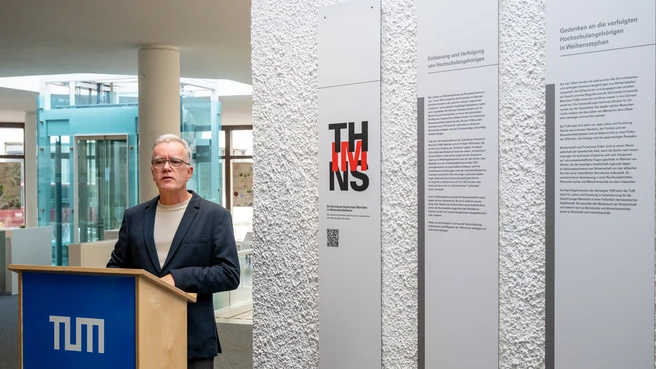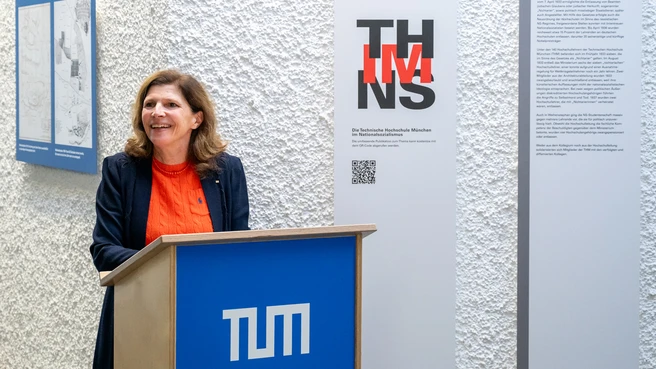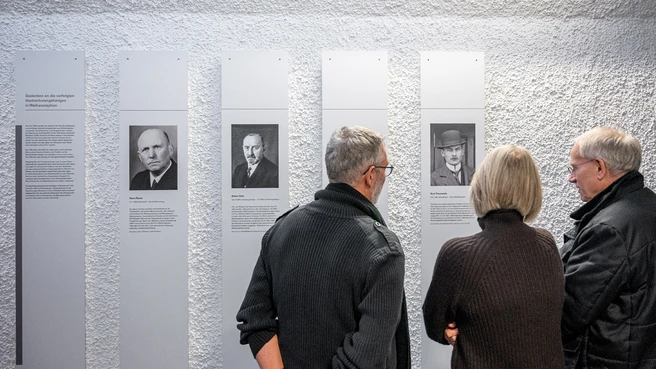Since July 2024, a memorial site on the TUM campus on Arcisstraße in Munich has commemorated 17 members of the former Technische Hochschule München (THM), the predecessor of TUM, who were dismissed and persecuted by the Nazi regime. Among those presented are four professors from Weihenstephan, which is why a separate commemorative space has now been dedicated to them on the campus in Freising.
These university professors dismissed by the National Socialists were Hans Raum (Professor of Plant Breeding and Cultivation), Anton Fehr (Professor of Dairy Farming), Carl Sachs (Associate Professor of Economics and Agricultural Policy), and Kurt Trautwein (Associate Professor of Theoretical Fermentation Physiology).
Dean and Vice President on the responsibility of science
Prof. Martin Klingenspor, Dean of the TUM School of Life Sciences, welcomed guests to the opening of the commemorative space, including TUM Vice President Prof. Jeanne Rubner and Prof. Winfried Nerdinger. The event also inspired Prof. Klingenspor to address the topic of moral courage – not only as citizens: “We also need courage as scientists to defend academic freedom.”
In her speech, Prof. Jeanne Rubner reminded the audience that persecution during the Nazi era was not only brutal for those who suffered it but also left huge gaps in German science. “At TUM, we acknowledge our responsibility for a dark past that also played out at the THM at that time,” said Prof. Rubner. “This place, which we are opening today, is intended to serve as a constant reminder of our university's history during the Nazi era.”
TUM processing the Nazi history of THM
Vice President Rubner thanked Prof. Winfried Nerdinger, who supported TUM with his knowledge and expertise in processing the past during the Nazi era. TUM has renamed rooms and buildings that bore the names of individuals with a controversial past (see also: TUM consistently continues to come to terms with its history during the Nazi era).
Prof. Winfried Nerdinger then made a speech: Until 2012, he was Professor of Architectural History and Director of the TUM Architecture Museum, subsequently becoming the founding director of Munich’s Documentation Centre for the History of National Socialism. He is also the editor of the book “Die Technische Hochschule München im Nationalsozialismus” (The Technical University of Munich under National Socialism). TUM offers this book as a free download a free download (full text in German as PDF, 367 pages, 79 MB).
Prof. Nerdinger's speech shed light on the entanglements with the Nazi regime: “There was no clean administration, no clean Wehrmacht, no ideology-free, pure science – those were legends. Science was not abused; there was a self-mobilization of science, and many were pushed into the party.”
Restructuring of the state and dismissals at universities
A few months after the NSDAP came to power, there was another turning point: the so-called “Law for the Restoration of the Professional Civil Service,” according to which civil servants were dismissed on ideological grounds. This affected 15 to 20 percent of university lecturers – “whose colleagues pushed for vacant positions and thus made themselves accomplices,” said Prof. Nerdinger.
Within a few weeks, the state and administration were in the hands of racists and anti-democrats, and vacant positions were mostly filled with party members. The Führer principle applied, and even the dean was the “Führer” of the faculty. Due to the Nuremberg Laws of 1937, other university members were dismissed, including two at THM.
The Nazi student’s league increased the pressure. It was strongly represented at THM, boycotted lectures, and conducted smear campaigns – these also contributed to the dismissals. The “Stürmer” also agitated against Prof. Anton Fehr, who had represented the “Bauernbund” (Farmers' League) in the German Reichstag during the Weimar Republic.
Prof. Nerdinger described the information boards about the four Weihenstephan professors as a “sign of their return to the university community.”
Agricultural research and armament under National Socialism
In Weihenstephan, the THM was directly involved in the Nazi state's autarky program to close supply gaps. Heinrich Himmler, himself a THM graduate in agricultural sciences, was particularly keen to promote agricultural research, and research funding was significantly increased. There was forced labor in Weihenstephan. Agricultural science later also served the “General Plan East” – eastern territories conquered during World War II were to be depopulated and “germanized", also with the aim of using the land for agriculture.
Other areas of research were also considered important for the war effort. Twenty-six institutes at the THM worked directly for the Wehrmacht – they were even referred to as “armaments enterprises.” Their scientists were exempt from military service because they were already serving on the so-called “research front.”
In conclusion, Prof. Nerdinger said that right-wing extremism and anti-Semitism still exist today, especially in times of crisis – and that these must be “countered with enlightenment and reason.”
Initiatives for commemorative spaces on the main campus and in Weihenstephan
The establishment of the commemorative space on the main campus is an initiative of the TUM Senior Excellence Faculty (the interdisciplinary circle of Emeriti of Excellence, to which Prof. Winfried Nerdinger belongs) in cooperation with the TUM Center for Culture and Arts. The Emeriti of Excellence, and Prof. Hermann Auernhammer in particular, also provided the impetus to establish a separate memorial on the Weihenstephan campus. This was opened on October 31, 2025, in the Central Lecture Hall Building (ZHG).



